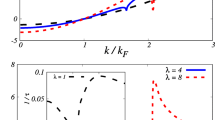Abstract
A general theory for the correlation functions of superfluid3He which takes into account rigorously the magnetic dipole interaction is developed. The resulting equations are solved for the Anderson-Brinkman-Morel (ABM) state and for wave vectorsq oriented parallel to the energy gap axis. Then the dispersion relations of low-frequency modes, including Fermi liquid corrections and damping due to pair breaking, are calculated in the zero-temperature and zero-field limit. There are two real frequency modes arising from each of the longitudinal and transverse spin density correlation functions: a spin wave and an orbit wave,both exhibiting a frequency gap where that of the spin wave is somewhat modified in comparison to the unperturbed longitudinal nuclear magnetic resonance frequency Ω /ABM L .The orbit wave is damped much more strongly than the spin wave. Further, there are two real frequency modes arising from the density correlation function: the sound wave, having a frequency gap of the order Ω /ABM L , and an orbit wave, exhibiting a gap in wave number of order Ω /ABM L /v F.—The NMR frequency undergoes a small splitting, which is the result of the splitting of the energy gap due to the dipole interaction. One of the two gaps still has nodes.—In addition to these low-frequency modes our equations yield resonances at frequencies of the order of the gap frequency Δ 0 /ħ, i.e., at ω=1.22 Δ 0 /ħ and at ω=1.58 Δ 0 /ħ. The damping and the oscillator strengths of these resonances are calculated.
Similar content being viewed by others
References
L. Tewordt, D. Fay, P. Dörre, and D. Einzel,J. Low Temp. Phys. 21, 645 (1975) (hereafter referred to as TFDE).
L. Tewordt and D. Einzel,Phys. Lett. 56A, 97 (1976).
A. J. Leggett and S. Takagi,Phys. Rev. Lett. 36, 1379 (1976).
L. Tewordt and D. Einzel,Bulletin Frühjahrstagung Deutsche Physikalische Gesellschaft, Freudenstadt (April 1976).
P. Wölfle,Phys. Rev. Lett. 37, 1279 (1976); and to be published.
A. J. Leggett,Rev. Mod. Phys. 47, 331 (1975).
M. C. Cross,J. Low Temp. Phys. 26, 165 (1977).
R. Combescot,Phys. Rev. Lett. 35, 1646 (1975).
B. R. Patton, inProc. of the 14th Int. Conf. on Low Temp. Phys., Otaniemi, Finland, 1975, M. Krusius and M. Vuorio, eds. (North-Holland, Amsterdam, 1975), Vol. 1, p. 17.
P. W. Anderson,Phys. Rev. 112, 1900 (1958).
N. N. Bogoliubov, V. V. Tolmachev, and D. N. Shirkov,New Method in the Theory of Superconductivity (English transl.: Consultants Bureau, New York, 1959).
J. C. Wheatley,Rev. Mod. Phys. 47, 415 (1975).
Author information
Authors and Affiliations
Rights and permissions
About this article
Cite this article
Tewordt, L., Schopohl, N. & Vollhardt, D. Effect of dipole interaction on collective modes in3He-A. J Low Temp Phys 29, 119–147 (1977). https://doi.org/10.1007/BF00659092
Received:
Issue Date:
DOI: https://doi.org/10.1007/BF00659092



